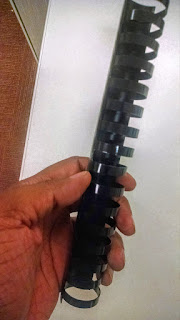Seems simple enough, right?
And so does the solution. I can just grab my handy dandy tablet/Chromebook/laptop, some digital text, and I'm off the reading races!
Unless. . . I don't tolerate digital text well.
But that's easy too! I can just create audio files and then. . . hmmm, that's a problem if I'm not big on audio.
So what do I do if I have trouble physically accessing text?
I recently ran into this issue at work, and the solution was surprisingly. . . simple.
To use the binding comb, we had the original binding cut off of the book. We usually do this so that we can scan a book when we can't get a digital copy of from the publisher or our usual sources (NOTE: DO NOT DO THIS AT HOME. We only do this for a student who has purchased a copy of the book. Their copy is what we cut and scan). Once we've scanned the book, we have it prepared for re-binding with a binding comb.
So what's so magical about this binding? How can it possibly be assistive technology for someone with a print disability?
I recently worked with a person who has difficulty physically manipulating a book. We had provided him with digital copies of his books because of this. However, he began developing severe migraines after reading digital text for a while. Yes, even after using the Nook Paper White. The digital text was actually becoming a bit of an issue. A regular text book could work if. . . it would just stay open.
Do you see where we're going with this? Light bulb moment hit yet?
Well, since his books needed to be cut to be scanned anyway, we re-bound them with binding combs and suddenly, we had a book that would stay open without the student having to hold it open.
Just that simple thing of re-binding the book made the difference for the student in making the book usable.
In our high-tech age, we forget the power of a simple, low-tech solution. Assistive technology doesn't only have to be a tablet/Chromebook or on a tablet/Chromebook. There are a lot of great assistive technology devices that come in those flavors, but not all of them do. As long as it helps an individual improve or maintain their functionality, it fits the definition. In this case, it's the comb binding and the rebound book. The "K.I.S.S." (Keep It Smart and Simple) Principle is often forgotten in assistive technology in favor of "cooler or flashier solutions." We can't be afraid to embrace the low-tech solution. Start there and end where you need to.


